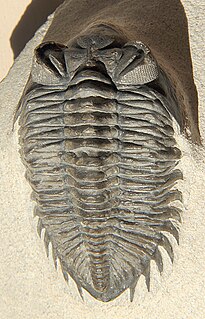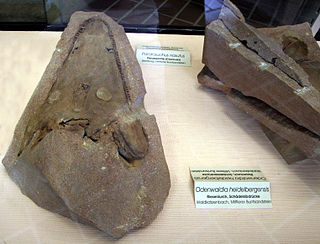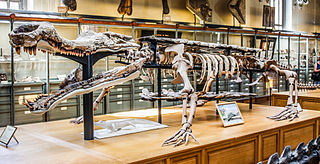 W
WAfrops larvifer is a phacopid trilobite which lived in a marine environment during the Pragian stage in what is now southwestern Algeria. The holotype and only known specimen is an incomplete cephalon that was described by G. Alberti in 1983.
 W
WChebsaurus is a genus of quadrupedal, herbivorous, cetiosaurid sauropod dinosaur, specifically a eusauropod. It lived in present-day Algeria, in the Callovian aged Aïssa Formation. The type species, C. algeriensis, was named in 2005 by Mahammed et al. and is the most complete Algerian sauropod known. It was around 8 to 9 metres long.
 W
WColtraneia is a genus of trilobite, that lived during the upper Emsian and lower Eifelian, and has been found in Algeria, France, Germany, Morocco and Spain.
 W
WMawsonia is an extinct genus of prehistoric coelacanth fish, and the largest of this group, ranging from an estimated 3.5 metres up to 6.3 metres long. It lived during the Cretaceous period. Fossils have been found in the Bahia Group, Romualdo, Alcântara and Missão Velha Formations of Brazil, South America, as well as the Continental Intercalaire of Algeria and Tunisia, the Ain el Guettar Formation of Tunisia, and the Babouri Figuil Basin of Cameroon, Africa. Mawsonia was first described by British palaeontology Arthur Smith Woodward in 1907. The type species is Mawsonia gigas, named and described in 1907. Numerous distinct species have been described since then. M. brasiliensis, M. libyca, M. minor, and M. ubangiensis have all been proposed to be synonyms of M. gigas, although Léo Fragoso's 2014 thesis on mawsoniids finds M. brasiliensis valid and cautions against synonymizing M. minor without further examination. Several recent publications consider M. brasiliensis to be valid as well. Although initially considered to belong to this genus, "Mawsonia" lavocati is most likely referable to Axelrodichthys instead.
 W
WMonograptus is a genus of graptolites in the Order Graptoloidea. This particular genus is the last stage of the graptoloid evolution before its extinction in the early Devonian. A characteristic of the genus includes one uniserial stipes with very elaborate thecae. This particular genus contains large number of graptolite species and may not be monophyletic.
 W
WOdenwaldia is an extinct genus of mastodonsauroid temnospondyl within the family Heylerosauridae.
 W
WProgeronia is a genus of ammonites belonging to the family Perisphinctidae.
 W
WSarcosuchus is an extinct genus of crocodyliform and distant relative of living crocodylians that lived during the Early Cretaceous, from the late Hauterivian to the early Albian, 133 to 112 million years ago of what is now Africa and South America. It was one of the largest crocodile-line reptiles, reaching an average estimate of 9 m (30 ft) and 3.5 metric tons, but estimated to grow up to 9.5 m (31 ft) in body length and weigh up to 4.3 metric tons. It is known from two species, S. imperator from the early Albian Elrhaz Formation of Niger and S. hartti from the Late Hauterivian of northeastern Brazil, other material is known from Morocco and Tunisia and possibly Libya and Mali.
 W
WSowerbyceras is a genus of ammonoid cephalopods belonging to the family Phylloceratidae. These nektonic carnivores lived during the Jurassic period, from Oxfordian to Kimmeridgian age.
 W
WSpinosaurus is a genus of spinosaurid dinosaur that lived in what now is North Africa during the Cenomanian to upper Turonian stages of the Late Cretaceous period, about 99 to 93.5 million years ago. This genus was known first from Egyptian remains discovered in 1912 and described by German paleontologist Ernst Stromer in 1915. The original remains were destroyed in World War II, but additional material has come to light in the early 21st century. It is unclear whether one or two species are represented in the fossils reported in the scientific literature. The best known species is S. aegyptiacus from Egypt, although a potential second species, S. maroccanus, has been recovered from Morocco. The contemporary spinosaurid genus Sigilmassasaurus has also been synonymized by some authors with S. aegyptiacus, though other researchers propose it to be a distinct taxon. Another possible junior synonym is Oxalaia from the Alcântara Formation in Brazil.
 W
WXiphiorhynchus is an extinct genus of prehistoric swordfish that lived from the Eocene until the Miocene. Unlike the modern swordfish, both the upper and lower jaws of Xiphiorhynchus were extended into blade-like points.